The AMD Radeon R9 Fury Review, Feat. Sapphire & ASUS
by Ryan Smith on July 10, 2015 9:00 AM ESTPower, Temperature, & Noise
As always, last but not least is our look at power, temperature, and noise. Next to price and performance of course, these are some of the most important aspects of a GPU, due in large part to the impact of noise. All things considered, a loud card is undesirable unless there’s a sufficiently good reason – or sufficiently good performance – to ignore the noise.
Starting with voltages, with the latest update to GPU-Z (0.8.4) we now have a basic idea of what the R9 Fury series’ voltages are, so let’s take a look.
| Radeon R9 Fury Series Voltages | |||||
| R9 Fury X (Ref) Load | ASUS R9 Fury Load | Sapphire R9 Fury Load | Sapphire R9 Fury OC Load | ||
| 1.212v | 1.169v | 1.188v | 1.212v | ||
What we find is that the R9 Fury X tops out at 1.212v, a fairly typical voltage for a large 28nm GPU.
Meanwhile what’s of much greater interest is the difference between the two R9 Fury cards. The Sapphire Tri-X R9 Fury OC also tops out at 1.212v, indicating that it’s operating in the same voltage range as the reference R9 Fury X, and what we’d expect to see if AMD isn’t doing any power binning and just selecting Fiji chips for R9 Fury based on yields and attainable clockspeeds. The ASUS card on the other hand reports a notably lower voltage, topping out at 1.169v, 43mv below the Sapphire card.
This is an unexpected, though not unreasonable finding. We know that AMD has been carefully testing chips and more closely assigning operating voltages to them based on what the chips actually need in order to improve their energy efficiency. As a result it looks like the ASUS card ended up with a better chip as part of the overall random distribution of chips, i.e. the chip lottery. We’ll revisit this point in a little bit, but for now it’s something to keep in mind.
Moving on, let’s take a look at average clockspeeds.
| Radeon R9 Fury Series Average Clockspees | ||||
| Game | R9 Fury X (Ref) | ASUS R9 Fury | Sapphire R9 Fury | |
| Max Boost Clock | 1050MHz | 1000MHz | 1040MHz | |
| Battlefield 4 |
1050MHz
|
1000MHz
|
1040MHz
|
|
| Crysis 3 |
1050MHz
|
1000MHz
|
1040MHz
|
|
| Mordor |
1050MHz
|
1000MHz
|
1040MHz
|
|
| Civilization: BE |
1050MHz
|
1000MHz
|
1040MHz
|
|
| Dragon Age |
1050MHz
|
1000MHz
|
1040MHz
|
|
| Talos Principle |
1050MHz
|
1000MHz
|
1040MHz
|
|
| Far Cry 4 |
1050MHz
|
1000MHz
|
1040MHz
|
|
| Total War: Attila |
1050MHz
|
1000MHz
|
1040MHz
|
|
| GRID Autosport |
1050MHz
|
1000MHz
|
1040MHz
|
|
| Grand Theft Auto V |
1050MHz
|
1000MHz
|
1040MHz
|
|
| FurMark |
985MHz
|
902MHz
|
988MHz
|
|
All of these cards are well-cooled, and as a result they have no trouble sustaining their rated clockspeeds when running our benchmark suite games. This is the case even for the ASUS card, which has a much lower power limit, as evidenced by the lower average clockspeed under FurMark.
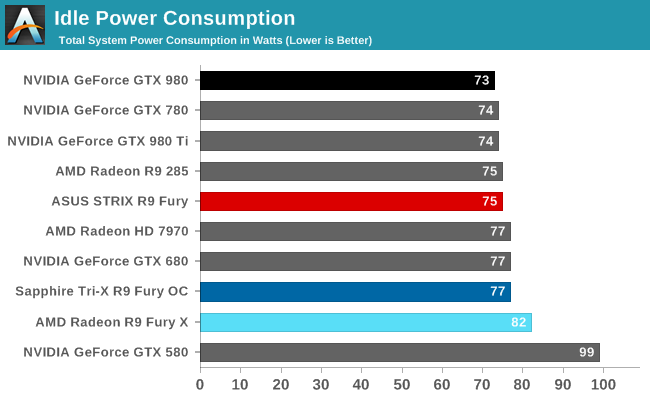
Shifting gears to power consumption, we knew at the time of the R9 Fury X that it was paying a slight idle power penalty as a result of its closed loop liquid cooler, and now we have a better idea of just what that penalty is. It essentially costs AMD another 5W at the wall to run the R9 Fury X’s pump, which means that the air-cooled R9 Fury’s idle power consumption is right in line with other air cooled cards. The fact that the ASUS and Sapphire cards are consistently 2W apart was a bit surprising, though likely a consequence of their difference PCB designs.
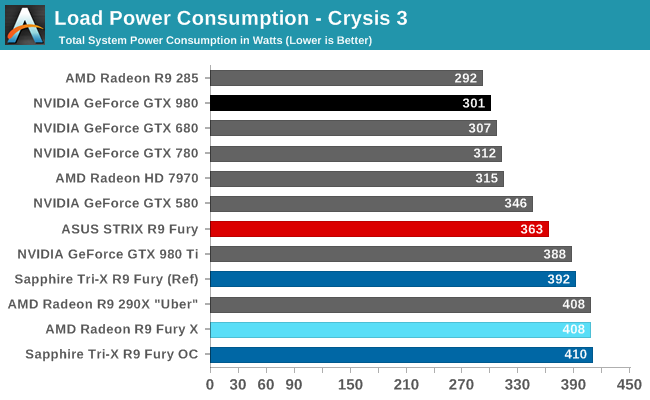
Load power consumption on the other hand is a poignant reminder that the R9 Fury is still a Fiji card, and that AMD can’t match the energy efficiency of NVIDIA’s Maxwell cards even under better circumstances. The Fury cards have a several percent performance lead over the GTX 980, but their power consumption in turn is much, much higher. The difference is between 62W and 109W at the wall, closer to large, power-hungry cards like the R9 Fury X and GTX 980 Ti than the smaller GTX 980 that the R9 Fury is competing with.
Overall the power gap is influenced by several factors. The R9 Fury cards run hotter than R9 Fury X, leading to more leakage. On the other hand disabling some CUs saves power, offsetting the increased leakage. But at the end of the day the R9 Fury is meant to be a 275W TBP card, just like the R9 Fury X, and that’s what we see here.
With that said, the difference between the ASUS and Sapphire cards is extremely surprising. The ASUS card has a lower power limit, but with the card sustaining 1000MHz under Crysis 3, that’s not what’s going on here. Rather we seem to be seeing the result of random chip variation quite possibly combined with ASUS’s custom PCB. Keep in mind what we said earlier about voltages, the ASUS card operates at a lower voltage than the Sapphire card, and as a result it has an advantage going into our power testing. Still, I would normally not expect a 43mv difference to lead to such significant savings.
This is a particular case where I’m curious what we’d find if we tested multiple ASUS cards, rather than looking at a sample size of 1. Would other ASUS cards have worse chips and draw more power? We’d expect so, but there may still be an advantage from ASUS’s PCB design and BIOS that need to be accounted for. At the very least it helps to close the efficiency gap between the R9 Fury and GTX 980, but it’s still not going to be enough.
Finally, since Sapphire also sent over the stock BIOS for their card we quickly tested that as well. Power consumption is down slightly thanks to slightly lower clockspeeds coupled with a lower maximum voltage of 1.188v. Still, even configured as a stock card, the ASUS card is well ahead in energy efficiency.
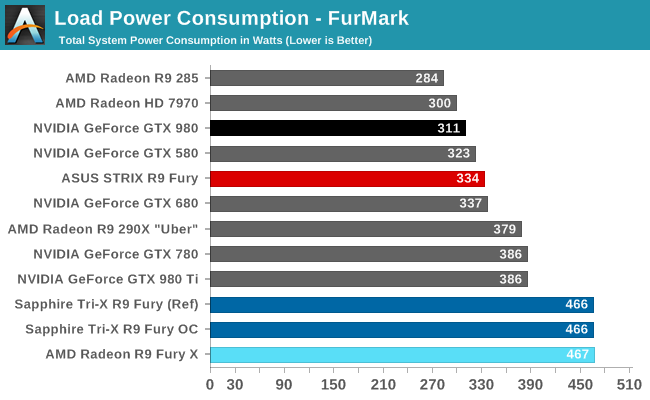
As for FurMark, we get the results more or less exactly what we were expecting. The Sapphire card with its AMD reference PCB and the high power delivery limits that entails throttles very little on FurMark, and as a result power consumption at the wall is quite high. On the other hand the ASUS card has its much lower default power limit, resulting in much heavier throttling under FurMark and keeping maximum power consumption down as well.
The end result is that the Sapphire card has a much wider range than the ASUS card, and it also indicates that the ASUS card’s power limit is likely not very far above what it takes to sustain 1000MHz under most games. The ASUS card will likely need more power to avoid power throttling if overclocked.
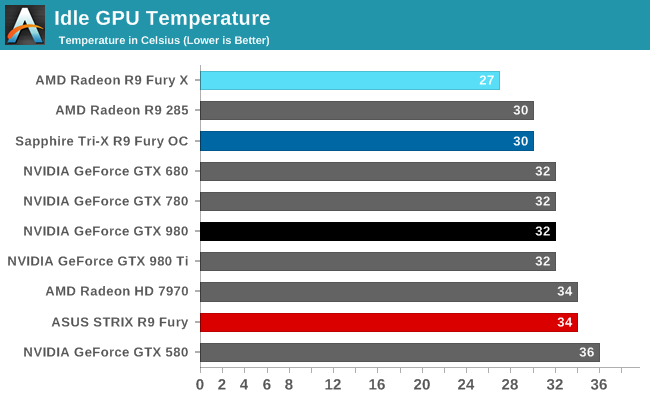
Moving on to idle temperatures, both R9 Fury cards fare relatively well here. The fact that they have no active cooling due to their zero fan speed idle technologies means that they run a bit warmer at idle, but it’s nothing significant.
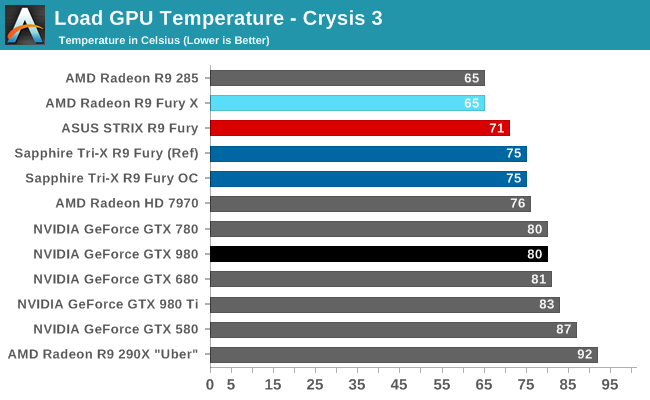
Crysis 3 temperatures meanwhile are in-line with what these cards are designed for. The Sapphire card is designed to run at up to 75C, and that’s exactly what happens here. The ASUS card on the other hand is a bit more aggressive with its fan early on, leading to it topping out at 71C. Both, as expected, are warmer than the R9 Fury X, which is not a major problem, but it does contribute to the lower energy efficiency we’ve been seeing, particularly for the Sapphire card.
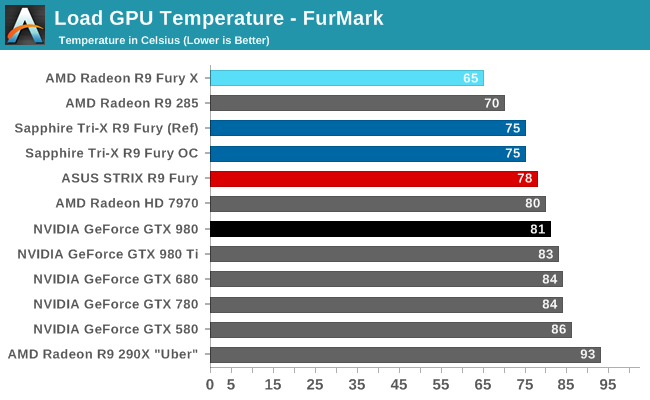
FurMark on the other hand changes things slightly. The Sapphire card holds at 75C and ramps up its fan, while the ASUS card is already operating at its first fan speed limit, and as a result is allowed to increase in temperature instead. What’s holding back the ASUS card at this point and preventing it from getting warmer yet is its power limit; the card can only generate enough heat to get up to 78C with its fans running at their first limit.

Last but not least, we have our noise measurements, starting with idle noise. The Sapphire and ASUS cards both feature zero fan speed idle technology, which means neither card is running their fans here. As a result the cards are outright silent. What we end up measuring is the background noise, mainly the fans and pumps of our CPU’s closed loop liquid cooler. At this point zero fan speed idle technology is not cutting edge, but it is never the less impressive. High-end HTPC users, or just users looking for a very quiet card at idle should be very happy with either card.

When it came time to run our load noise testing we were expecting good things from both cards, but the results from the Sapphire Tri-X have completely blown our expectations. With sub-40dB(A) noise levels we ended up running our load noise test three different times in order to make sure there wasn’t an error in our testing methodology. There wasn’t.
What we have here then is the quietest high power air cooled card we have ever tested. In its OC configuration the Sapphire Tri-X card tops out at 38.2dB under Crysis 3, less than 2dB(A) above our noise floor and nearly 5dB quieter than the quiet R9 Fury X. Switching to its reference configuration drives noise levels down even further, to just 37.8dB(A). To put that in perspective, the Sapphire Tri-X under a gaming workload is as loud as the GTX 980 Ti is at idle. Simply put, these results are amazing.
In going over the design of Sapphire’s card there is no doubt that this is the product of several factors – not the least of which is the massive heatsink – but going back to what we said earlier about the short PCB, we’re left to wonder if that didn’t have a significant impact. By being able to blow hot air straight back (or rather, straight up), the card reduces the amount of airflow and noise being reflected against the back of the card, but it also offers a more direct cooling route that in principle reduces the amount of work the fans need to do. In any case we’ve seen Sapphire’s Tri-X cards do well before, but at 38dB(A) this is a new high water mark that is going to be difficult to beat.
Which on that note, puts the ASUS card in an awkward position. Compared to just about anything else, 46.2dB would be doing well for an open air card. But at an 8dB(A) difference between it and the Sapphire card, the difference is night and day. ASUS has to run their fans so much faster that they just can’t match what Sapphire has done. It’s a solid card, but when it comes to acoustic testing it has the misfortune of going up against some very capable competition.
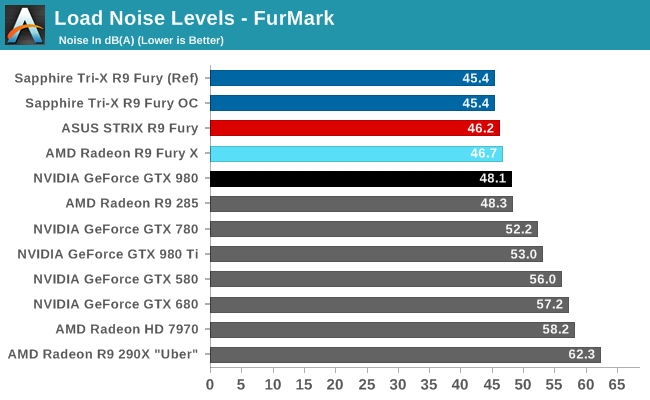
Finally we have our noise levels under FurMark. What’s interesting here is that with the ASUS card still running at its first maximum fan speed (44%), it doesn’t get any noisier under FurMark than it does Crysis 3. The Sapphire card on the other hand does need to ramp up its fans significantly to handle the extra heat. None the less the Sapphire card still ends up being a bit quieter, topping out at 45.4dB. And when taking into consideration the significant difference in power limits between the two cards, it’s clear that the Sapphire card is remaining quieter while performing a great deal more work.










288 Comments
View All Comments
Socius - Saturday, July 11, 2015 - link
Yes...comparing an overclocked 3rd party pimped model against a non-OC'd reference design card that is $100 less in price and then saying it's a tough choice between the 2 as the R9 Fury is faster than the GTX 980...lol...totally balanced perspective there bro.Ryan Smith - Saturday, July 11, 2015 - link
Whenever a pure reference card isn't available, like is the case for R9 Fury, we always test a card at reference clockspeeds in one form or another. For example in this article we have the ASUS STRIX, which ships at reference clockspeeds. No comparisons are made between the factory overclocked Sapphire card and the GTX 980 (at the most we'll say something along the lines of "both R9 Fury cards", where something that is true for the ASUS is true for the Sapphire as well).And if you ever feel like we aren't being consistent or fair on that matter, please let us know.
Socius - Saturday, July 11, 2015 - link
I just want to understand something clearly. Are you saying that when you are talking about performance/value, you ignore the fact that one card can OC 4%, and the other can OC 30% as you don't believe it's relevant? Let me pose the question another way. If you had a friend who was looking to spend $500~ on a card and was leaning between the R9 Fury and the GTX 980. Knowing that the GTX 980 will give him better performance once OC'd, at $450, would you even consider telling him to get the R9 Fury at $550?My concern here is that you're not giving a good representation of real world performance gamers will get. As a result, people get misled into thinking spending the extra money on the R9 Fury is actually going to net them higher frame rate...not realizing they could get better performance, for even less money, if someone decided to actually look at overclocking potential...
Now if you weren't interested in overclocking results in general, I'd say fine. I disagree, but it's your choice. But then you do show overclocking results with the R9 Fury. I'm finding it really hard to understand what your intent is with these articles, if not to educate people and help them make an actual informed decision when making their next purchase.
As I mentioned in your previous article on the Fury X...you seem to have a soft spot for AMD. And I'm not exactly sure why. I will admit that I'm currently a big Nvidia fan. Only because of the features and performance I get. If the Fury X had come out, and could OC like the 980ti and had 8gb HBM memory, I'd have become an AMD fan. I'm a fan of whoever has the best technology at any given moment. And if I were looking to make a decision on my next card purchase, your article here would give a false impression of what I would get if I spent $100 more on an R9 fury, than on a GTX 980...
jardows2 - Saturday, July 11, 2015 - link
Apparently, OC is your thing. I get it. There are plenty of OC sites that are just for you. For some of us, we really don't want to see how much we can shorten the life of something we pay good money for, when the factory performance does what we need. I, for one, am more interested in how something will perform without me potentially damaging my computer, and I appreciate the way that AT does their benchmarks.Socius - Saturday, July 11, 2015 - link
I think the fact that you believe overclocking will "damage your computer" or in any meaningful way shorten the lifespan of the product, is all the more reason to talk about overclocking. I'd be more than welcome to share a little info.Generally speaking, what kills the product is heat (minus high current degradation that was a bigger problem on older fab processes) So let's say you have a GPU that runs 60 degrees Celsius under load, at 1000MHz with a 50% fan speed profile. Now let's imagine 2 scenarios:
1) You underclock the GPU to 900MHz and set a 30% fan profile to make your system more quiet. Under load, your GPU now hits 70 degrees Celsius.
2) You overclock the GPU to 1100MHz and set a 75% fan profile for more performance at the cost of extra sound. Under load, your GPU now hits 58 degrees Celsius due to increased fan speed.
Which one of these devices would you think is likely to last the longest? If you said the Overclocked one, you'd be correct. In fact...the overclocked one is likely to last even longer than the stock 1000MHz at the 50% fan speed profile, because despite using more power and giving more performance, the fan is working harder to keep it cooler, thus reducing the stress on the components.
Now. Let's talk about why that card was clocked at 1000MHz to start! When a chip is designed, the exact clock speed is an unknown. Not just between designs...but between individual wafers and dies cut out from those wafers. As an example, I had an i7 3770k that would use 1.55v to hit 4.7GHz. I now have one that uses 1.45v to hit 5.2GHz and 1.38v to hit 5GHz. Why am I telling you this? Well...because it's important! When designing a product like a CPU or GPU, and setting a base clock, you have to account for a few things:
1) How much power do I want to feed it?
2) How much of the heat generated by that power can I dissipate with my fan design?
3) How loud do I want my fan to be?
4) What's the highest clock rate my lowest end wafer can hit while remaining stable and at an acceptable voltage requirement?
So here's the fun part. So while chips themselves can vary greatly, there are tons of precautions added when dealing with stock speeds. Just for a point of reference...a single GTX Titan X is guaranteed to overclock 1400MHz-1550MHz with proper settings, if you put the fan at 100% full blast. That's a 30%-44% overclock! So why wouldn't Nvidia do that? Well it's a few things.
1) Noise! Super important here. Your clockspeed is determined by your ability to cool it. And if you're cooling by means of a fan, the faster that fan, the more noise, the more complaints by consumers.
2) Power/Heat variability. Since each chip is different, as you go into the higher ranges, each will require a different amount of power in order to be stable at that frequency. If you're curious, you can see what's called an ASIC quality for your GPU using a program like GPU-Z. This number will tell you roughly how good of a chip you have, in terms of how much of a clock it can achieve with how much power. The higher the % of your ASIC quality, the better overclocking potential you have on air because it'll require less power, and therefore create less heat to do it!
3) Overclocking potential. This is actually important in Marketing. And it's something AMD and Nvidia are both pretty bad at, actually. But AMD's bit a bit worse, to their own detriment. In their R9 Fury and Fury X press release performance numbers they set expectations for their cards to completely outperform the 980ti using best case scenarios and hand picked settings. And they also said it overclocks like a beast. Now...here's why that's bad. Customers like to feel they're getting more than what they pay for. That's why companies like BMW always list very modest 0-60 times for their cars. When I say modest, I mean they set the 0-60 times to show they're worse than what the car is actually capable of. That's why every car review program you see will show 0-60 times being 0.2 to 0.5 seconds faster than what BMW has actually listed. This works because you're sold on a great product, only to find it's even greater than that.
Got off track a bit there. I apologize. Back to AMD and the Fiji lineup and why this long post was necessary. When AMD announced the Fury X being an all in one cooler design, I instantly knew what was up. The chip wasn't able to hold up to the limitations we talked about above (power requirement/heat/fan noise/stability). But they needed to put out a stock clock that would allow the card to be competitive with Nvidia, but they also didn't want it to sound like a hair dryer. That's why they opted for the all in one cooler design. Otherwise, a chip that big on an air cooled design would likely have been clocked around the 850-900MHz range that the original GTX Titan had. But they wanted the extra performance, which created extra heat and required more power, and used a better cooler design to be able to accomplish that across the board with all their chips. That's great, right? Well...yes and no. I'll explain.
Essentially the Fiji lineup is "factory overclocked" by AMD. This is the same as putting a turbo on a car engine. And as any car enthusiast will tell you, a 2L engine with a turbo on it may be able to produce 330 horsepower, which could otherwise take a naturally aspirated 4L V8 to accomplish. But then you're limited for increased horsepower even further. Sure you could put a bigger supercharger on that 2L engine. But it already had a boosted performance for that size engine. So your gains will be minimal. But with that naturally aspirated engine...you can drop a supercharger on it and realize massive gains. This is very much the same as what's happening with the Fury X, for example.
And this is why I believe it's incredibly important to point this out. I built a system for my friend recently with a GTX 970. I overclocked that to 1550MHz on first try, without even maxing out the voltage. That was a $300 model card. And even that would challenge the performance of the R9 Fury if you don't plan on overclocking (not that you could, anyway, with that 4% overclock limit).
So...yes, I do think Overclocking needs to be talked about more, as it's become far easier and safer to do than in the past. Even if you don't plan to do extreme overclocking, you can keep all your fan speed automated profiles the same, don't touch voltage, and just increase power limit and a slight increase in the gpu clock for simple free performance. It's something I could teach my mom to do. So I hope it's something that is done by more and more people, as there's really no reason not to do it.
And that's why I think informing people of these differences with regard to overclocking will help people save money, and get more performance. And not doing just keeps people in the dark, and does them a great disservice. Why keep your audience oblivious and allow them to remain ignorant to these things when you can take some time to help them? Overclocking today is far different from the overclocking of a few years ago. And everybody should give it a try.
mdriftmeyer - Sunday, July 12, 2015 - link
Ryan is biased in these comparisons. That's a fact. Your knowledge silencing the person defending Ryan's unbalanced comparisons is a fact.jardows2 - Monday, July 13, 2015 - link
What a hoot! He didn't silence me. I just have better things to do on the weekend than check all the Internet forums I may have posted to!jardows2 - Monday, July 13, 2015 - link
@SociusThat was a good post explaining your interest in OC. From my perspective, I come from the days when OC'ing would void your warranty and would shorten the life span of your system. I also come from a more business and channel oriented background, meaning that we stay with "officially supported" configurations. That background stays with you. Even today, when building my personal computer or a web browsing computer for a family member, I do everything I can to stay with the QVL of the motherboard.
I am more concerned with out of box experience, and almost always skip over the OC results of benchmarks whenever they are presented. If a device can not perform properly OOB, then it was not properly configured from the start, which does not give me the best impression about the part, regardless of the potential of individual tweaks.
In the end, you are looking for OC results, I am only concerned with OOB experience. Different target audience, both with valid concerns. I just don't think it is worth bashing a reviewer's method that focuses on one experience over the other.
Mugur - Saturday, July 11, 2015 - link
Good review as always, Ryan. I wouldn't throw away Asus's approach. Nice power efficiency gains. Funny how overclocking for a few fps more heated the discussion... All in all, I think AMD is back in business with Fury non-X. Waiting for 3xx reviews, hopefully for the whole R9 line, with 2, 4 and 8 GB.3ogdy - Saturday, July 11, 2015 - link
What a disappointment again. Man...the Fury cards really aren't worth the hassle at all, are they? It's sad to see this, especially coming from an FX-8350 & 2xHD6950s owner. So the 980Ti beats the custom cards (we knew Fury X was quite at its limits from the beginning, but still - despite all the improvements, custom cards sometimes perform even worse than the stock one. The 980Ti really beats the Fury X most of the time.What is that, nVidia's blower is only 8dB louder than the highest end of the fans used by arguably the two best board partners AMD has? Wow! This is where I realize nVidia really must have done an amazing job with the 980Ti and Maxwell in general.
HBM this HBM that...this card is beaten at 4K by the GTX980Ti and gameplay seems to be smoother on the nVidia card too. What the hell? Where are the reasons to buy any of the Fury cards?